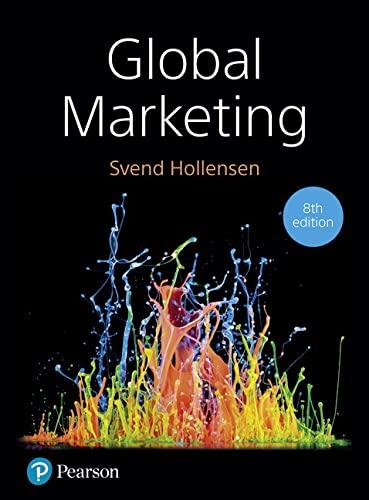Royal Philips Electronics of the Netherlands is one of the worlds biggest electronics companies, as well as
Question:
Royal Philips Electronics of the Netherlands is one of the world’s biggest electronics companies, as well as the largest in Europe In 1891, the Dutch mechanical engineer Gerard Philips started the production of carbon-filament lamps in a former buckskin factory in Eindhoven.
Among his first major clients were early electricity companies which included the provision of lamps in their power supply contracts.
Philips is number one in the world market for lighting. Its lighting products (light bulbs and lamps)
are found all around the world: not only everywhere in the home, but also in a multitude of professional applications, for example, in 30 per cent of offices, 65 per cent of the world’s top airports, 30 per cent of hospitals, 35 per cent of cars and 55 per cent of major football stadiums.
Competition
Philips Lighting is the world leader in lighting products manufacturing. Its market shares are 50 per cent in Europe, 36 per cent in North America and 14 per cent in the rest of the world. Since the 1980s, Philips has participated intensively in the concentration of this industrial sector by purchasing smaller national companies such as Companie des Lampes (France), AEG (Germany) and Polam Pila (Poland). It has also developed joint ventures with Westinghouse Lamps, Kono Sylvania and EBT China.
GEL
General Electric Lighting (GEL) holds a 50 per cent share of the US market but had only a 2 per cent market share in Europe in 1988. In order to reach a 30 per cent market share in 2010, GEL acquired several European national companies, such as Tungsram (Czechoslovakia), Thorn Emi (UK), Sivi (Italy) and Linder Licht (Germany). In 1994 GEL built a logistics unit in France to supply France, Germany, Benelux, Switzerland, Italy and Austria. It now intends to reduce prices in connection with supermarket chains.
Osram
A 100 per cent subsidiary of the giant German holding Siemens, Osram achieves an 86 per cent share of its turnover by exporting (46 per cent in North America, 41 per cent in the EU, 6 per cent in South America and 6 per cent in Asia). The strategy for the coming years is to increase Asian market shares by doubling its turnover in Asia.
Other significant manufacturers are Sylvania Lighting International and Panasonic.
Philips Lighting market screening in the Middle East
At the beginning of the twenty-first century, Philips needed a coherent marketing strategy for the whole Middle East region. The first task was to select the most attractive markets in the region. Over the years Philips has developed a model which shows a correlation between a country’s demand for lighting and its GDP per capita. During discussions with agents/distributors in many countries, Philips was completely dependent on its information about market size. If Philips underestimated market size, it missed market opportunities. That was the main reason why this model was developed, so that the company could cross-check market estimations of its agents/distributors......
Questions
1. Discuss the appropriateness of the screening model used in this case.
2. Suggest another screening model that could be relevant for Philips Lighting to use in the Middle East.
Step by Step Answer:






